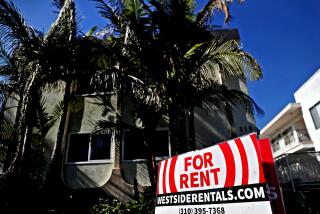The Pros and Cons of Lease-Option Deals
- Share via
Recently, I drove by a vacant house that had been listed for sale at least three or four months. I noticed the “for sale” sign was gone, but I didn’t recall seeing a “sold” sign. Later that morning I saw a salesman with the brokerage that held the listing.
“How much did that house sell for?” I asked.
“Oh, that one,” he replied. “The listing agent gave up because it is on such a busy street, and the seller was asking too much.” Then he added, “The owners will probably try to rent it, although they are moving out of town and really would prefer a sale.”
It’s too bad that listing agent didn’t suggest a lease-option to the seller because that house is a perfect candidate: It’s vacant. The seller is moving out of town and apparently doesn’t need an immediate sale. The seller also wants top dollar.
Although the seller’s asking price was a bit above market value, if the seller would agree to a lease-option and a decent rent credit for the tenant-buyer, the listing agent could have salvaged a sales commission. Lease-option realty commissions are usually paid partly up-front, and then the balance is paid when the buyer eventually exercises the option to purchase.
Most buyers, sellers and agents don’t understand the pros and cons of lease-options. A lease-option is a combination of a rental agreement with an option for the tenant to buy the property at an agreed option purchase price. The key to lease-option success, I’ve found, is the rent credit. If it’s too low, the tenant has no incentive to exercise the option to buy. If it’s too high, the seller doesn’t maximize his or her profit.
For example, suppose the monthly rent on a house or condo is $1,500 with a 33% rent credit. That means every month the tenant builds a $500 “forced savings account” toward a purchase price down payment. At the end of a year, that’s $6,000. Several times I’ve had lease-option tenants build up $30,000 rent credits over five years so they could buy their houses with virtually no cash from their pockets except for closing costs. However, I had the right to annually raise the option purchase price in rising markets.
There’s a lease-option tax advantage many sellers and their agents usually don’t consider. Internal Revenue Code 121 gives principal residence sellers up to a $250,000 per qualified seller tax exemption. The seller must own and occupy the primary residence an “aggregate” two years during the five years before the sale.
That means the seller can rent the house for up to three years after moving out without losing this generous tax exemption. Suppose the lease-option term is two years. At the end of that time, if the tenant-buyer purchases the home, its seller can then claim the $250,000 exemption (up to $500,000 for a married couple filing jointly).
Or the seller can even use a Starker Internal Revenue Code 1031 tax-deferred exchange of rental property to “trade up” to other investment or rental property without paying capital gains tax. Such a tax-deferred exchange works especially well if the seller has more than a $250,000 (or $500,000) sale profit.
When I’m a lease-option seller, I usually give my tenants a 33% rent credit. I find this is fair to both seller and buyer.
Most sellers and agents think lease-options favor buyers. I strongly disagree. As a frequent lease-option seller, I find seller advantages include higher than market rent, excellent quality tenants who expect to buy the home and top dollar option sales price. From the buyer’s viewpoint, the longer the lease-option term, the better. As a buyer, the best lease-option I ever negotiated was for 15 years. However, as a lease-option seller, I only negotiate one-year renewable lease-options so I can “adjust” the option purchase price if market values go up.
Very few lease-options are advertised. The buyer demand is always far stronger than seller supply. As soon as a lease-option becomes available, a buyer usually snaps it up.
For this reason, lease-option buyers must be proactive and learn to create their own lease-options. That’s what I did when purchasing my personal residence.
A superb lease-option source is “houses for rent” classified ads. After inspecting a house for rent that I would like to buy on a lease-option, I ask the landlord if he or she would consider selling on a lease with option to buy. Surprisingly, many landlords would like to sell and get out of the rental business, especially when no real estate sales commission is involved.
To entice the landlord further, I offer a tempting, nonrefundable option consideration, which applies toward the purchase price. Usually $5,000 or $10,000 works well because that amount is far higher than the landlord was expecting for a security deposit.
If that still isn’t enough, remind the landlord he or she will continue to enjoy the depreciation and other tax deductions. Finally, offer to give the landlord a year’s post-dated rent checks so all he or she must do is remember to deposit one in their bank account on the first day of each month.
If you’re having trouble finding a lease-option residence, try running a classified ad for a month under “homes wanted.”
*
Robert J. Bruss is a syndicated columnist as well as a real estate investor, lawyer, broker and educator in the Bay Area.
More to Read
Inside the business of entertainment
The Wide Shot brings you news, analysis and insights on everything from streaming wars to production — and what it all means for the future.
You may occasionally receive promotional content from the Los Angeles Times.










